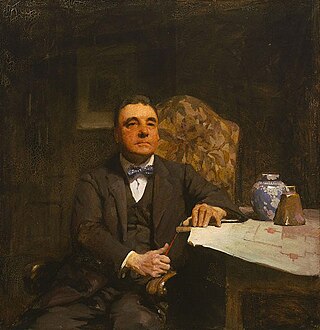
The Archibald Prize is an Australian portraiture art prize for painting, generally seen as the most prestigious portrait prize in Australia. It was first awarded in 1921 after the receipt of a bequest from J. F. Archibald, the editor of The Bulletin who died in 1919. It is administered by the trustees of the Art Gallery of New South Wales and awarded for "the best portrait, preferentially of some man or woman distinguished in Art, Letters, Science or Politics, painted by an artist resident in Australia during the twelve months preceding the date fixed by the trustees for sending in the pictures". The Archibald Prize has been awarded annually since 1921 and since July 2015 the prize has been AU$100,000.

Australian art is a broad spectrum of art created in or about Australia, or by Australians overseas, spanning from prehistoric times to the present day. The art forms include, but are not limited to, Aboriginal, Colonial, Landscape, Atelier, and Contemporary art.
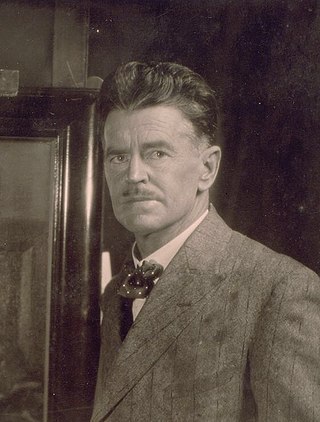
William Beckwith McInnes was an Australian portrait painter, winner of the Archibald Prize seven times for his traditional style paintings. He was acting-director at the National Gallery of Victoria and an instructor in its art school.
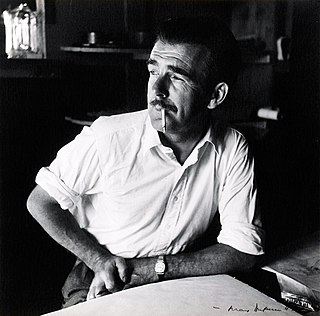
Sir William Dobell was an Australian portrait and landscape artist of the 20th century. Dobell won the Archibald Prize, Australia's premier award for portrait artists on three occasions. The Dobell Prize is named in his honour.
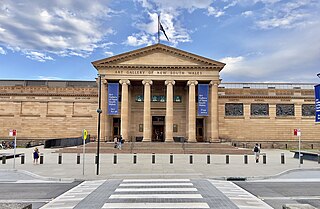
The Art Gallery of New South Wales (AGNSW), founded as the New South Wales Academy of Art in 1872 and known as the National Art Gallery of New South Wales between 1883 and 1958, is located in The Domain, Sydney, Australia. It is the most important public gallery in Sydney and one of the largest in Australia.

George Washington Thomas Lambert was an Australian artist, known principally for portrait painting and as a war artist during the First World War.
William Edwin Pidgeon, aka Bill Pidgeon and Wep, (1909–1981) was an Australian painter who won the Archibald Prize three times. After his death, cartoonist and journalist Les Tanner described him: "He was everything from serious draftsman, brilliant cartoonist, social observer, splittingly funny illustrator to multiple Archibald prizewinner.
Arthur James Murch was an Australian artist who won the Archibald Prize in 1949 with a portrait of Bonar Dunlop. Dunlop was a New Zealand artist sculptor and illustrator.

Ernest William Buckmaster (1897–1968) was an Australian artist born in Victoria. He won the Archibald Prize in 1932 with a portrait of Sir William Irvine. He also served as an Australian war artist during World War II.

Ben Quilty is an Australian artist and social commentator, who has won a series of painting prizes: the 2014 Prudential Eye Award, 2011 Archibald Prize, and 2009 Doug Moran National Portrait Prize. He has been described as one of Australia's most famous living artists.

Alethea Mary Proctor was an Australian painter, print maker, designer and teacher who upheld the ideas of 'taste' and 'style'.
Nigel Milsom is an Australian painter.

Neil Haddon is a British-Australian painter. His paintings display a wide variety of influences and styles, from hard edge geometric abstraction to looser expressive figurative painting. Haddon currently lives and works in Hobart, Tasmania.

Polly Hurry, was an Australian painter. She was a founding member of the Australian Tonalist movement and part of the Twenty Melbourne Painters Society.

Harold Frederick Abbott was an Australian portrait painter, an official war artist and an art teacher by profession.
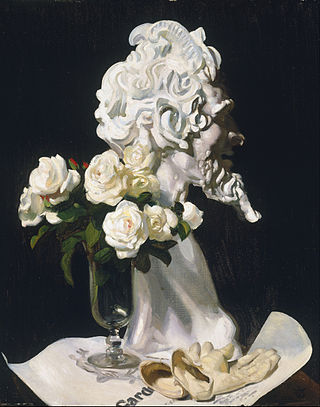
Pan Is Dead (Still Life) is a 1911 still life painting by Australian artist George Washington Lambert. The painting depicts "a sculpted head of Pan beside white gloves and a glass vase filled with white roses". Lambert created the bust of Pan as part of a costume for a character he played in a tableau vivant, The awakening of Pan, created in 1909 by the wife of the artist Philip Connard.
Lambert constructed a conceit in which he played upon the difference between how things appear on the surface of the canvas and how they are in reality. He abrogated the difference between the solid bust of Pan and the bunch of fragile white roses in the glass vase beside it by making the sculpted curls in Pan's hair resemble roses and by using sharply defined edges to 'sculpt' the flowers.

Mrs Annie Murdoch is a 1927 portrait painting by Australian artist George Washington Lambert. The painting depicts Annie Murdoch, the mother of newspaper proprietor Keith Murdoch and grandmother of businessman Rupert Murdoch. Murdoch commissioned this painting of his mother, who migrated to Australia from Scotland in 1884 with her Presbyterian minister husband, Patrick. Lambert painted the work in September 1927.
It is a striking portrait and full of character. Lambert portrayed the alert-faced matron, with her brown eyes looking directly out of the picture with confidence and authority. He showed her smiling with what might be interpreted as genial amusement

The White Glove is a 1921 portrait painting by Australian artist George Washington Lambert. The painting depicts Miss Gladys Neville Collins, the daughter of J.T. Collins, lawyer, Victorian State Parliamentary draughtsman, and trustee of the Public Library, Museums and National Gallery of Victoria.

Self-portrait with gladioli is a 1922 oil-on-canvas painting by Australian artist George Washington Lambert. The painting, a self-portrait, depicts Lambert in a brown velvet gown, wearing a purple scarf with a vase holding a gladiolus in front of him.
















